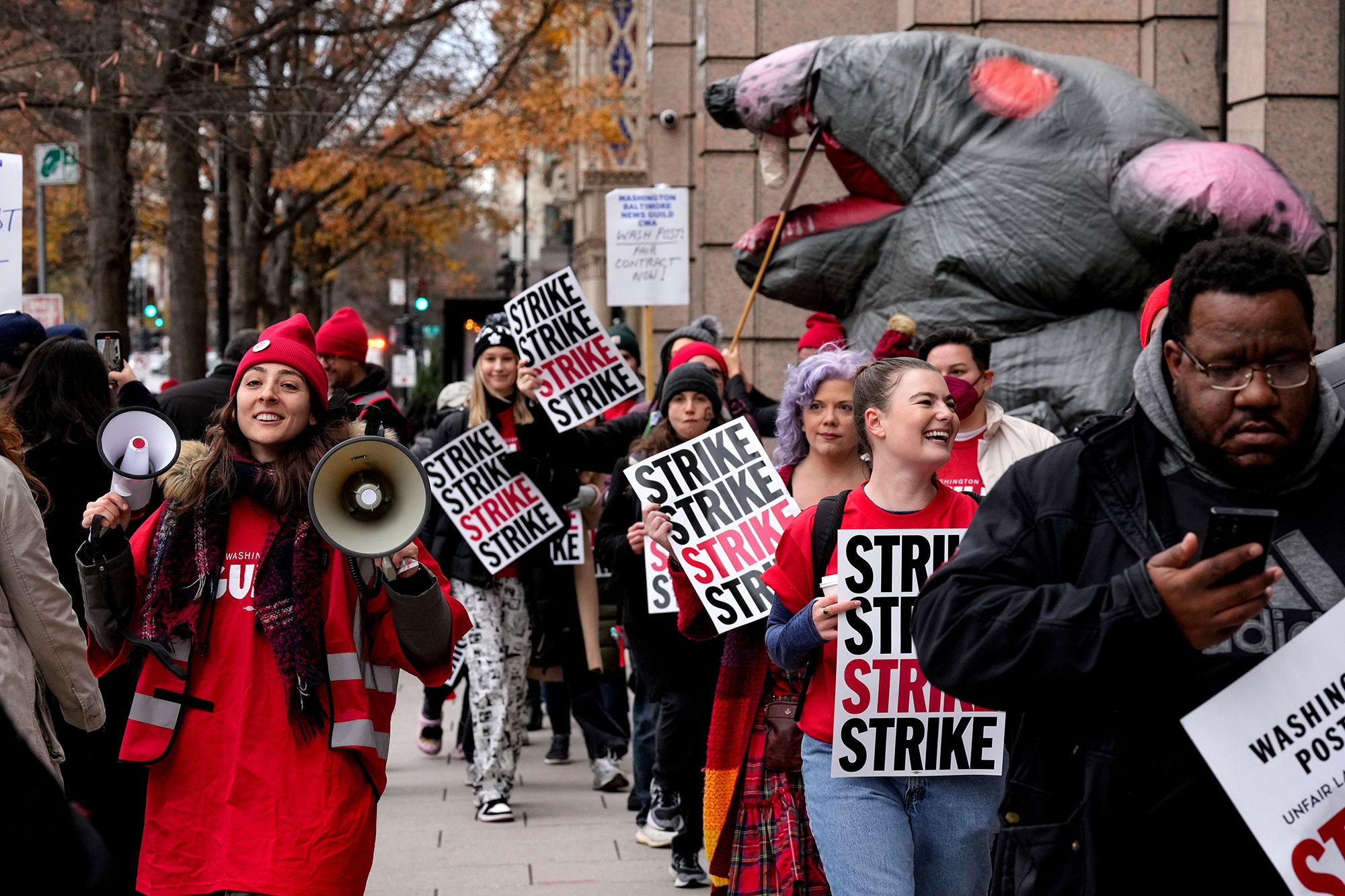"Why Washington Post Staff Staged a Walkout: Disgust All Around"

Written by Charlotte Klein
Over 700 staffers of Washington Post left their jobs for a day on Thursday in what can be described as a historical work pause to air their grievances over deadlocked union contract negotiations. According to one of the Post employees, the motivation for this action is a combination of various disappointments.
This strike, the first since the 1970s, as mentioned by the Post Guild leaders, commenced at Thursday midnight. Sarah Kaplan, a climate reporter for the Post, explains that the strike is a protest against the company's uncooperative bargaining tactics, its sudden ending of contract discussions and the buyouts announced earlier in the year. The strike can be defined as a statement from the Post staff drawing the company's attention to the need to deal fairly with its employees, and the fact that the newspaper cannot function without them. A picket line was set up in front of the company's headquarters in Washington, and staff participants started showing their disapproval from early morning.
According to Katie Mettler, a Metro reporter and a chair of the Post Guild for a long time, Jeff Bezos purchasing the paper a decade back with the hope of breaking even or making a profit. However, despite the employees ensuring profitability for the paper, the mismanagement by the previous publisher, Fred Ryan, had led to the squandering of profits. Fred Ryan, Katie added, is accountable to Jeff Bezos making it justifiable for them to hold him responsible for this mishap, considering that he can instruct the current corporate administrators to resume the negotiation process.
The Post Guild, the employee's union, has been involved in negotiations with the company for a year and a half. During this period, Ryan left, and Bezos appointed Patty Stonesifer, his long-time confidante, and an erstwhile Microsoft executive, as the interim CEO following which, Stonesifer appointed Will Lewis, Dow Jones, Wall Street Journal parent company, former CEO as the next publisher for the paper. In the same duration, the Post's business setbacks have been revealed, including a forecasted $100 million loss this year, and, mid-October, an offer of buyouts to 240 staff members across the board.
However, last week, Stonesifer informed the staff that the goal of 240 acceptances for the 'exit package' might necessitate "involuntary layoffs" seeing as by that point only 120 employees had accepted the offer. Initially, the company had offered buyouts with caps on every team, with the capping at the availability of buyouts to that respective team being limited. However, Stonesifer suggested in her memo last week that they would “consider raising caps based on minimizing the impact on our mission and product." The staff, on the other hand, has been demanding a clear long-term strategy, both businesswise and editorially.
The Guild is demanding three-year, 4%-per-year increases, in contrast to the company's offer of 2.25% for the initial year and 2% over the subsequent couple of years. Kaplan stipulates the necessity of a contract that offers job security and honors length of service as well as the contribution of long-term employees to the company.
In response to this, a representative from the Post assures that they respect the rights of the colleagues participating in the strike and will minimize customer impact. The company maintains that, since the negotiation start, their aim has been to reach a mutual agreement with the Guild that accommodates both employee needs and company objectives.
With hundreds of staffers pledging support for the walkout earlier this week, a second Post staffer said “it’s going to be noticeable,” but questioned “whether it’s going to be effective.” In some cases, entire departments, such as the Metro and investigative teams, committed to walking out, Post reporter Marissa Lang said, as did “colleagues on the commercial side, and in the print plant,” who walked off their jobs in the early hours of Thursday morning. “A walkout of 750 people touches every part of the Washington Post organization,” said Lang. Earlier this week, Post Guild released an open letter asking readers to “respect our walkout by not crossing the picket line,” meaning “do not engage with any Washington Post content.” If you did read the Post on Thursday, though, you may have noticed some stories—like one about a new crime center in DC to the paper’s own coverage of its labor protest —had a general byline: “By Washington Post Staff.” Either reporters had their names stripped off stories, or the generically bylined pieces were written by editors.
Staffers I spoke to had mixed feelings about how much this action will really do. “I think people are genuinely impressed by how this young contention of leaders has revived the union, and doubled its membership,” said a third Post staffer. But “a lot of the same people are disappointed to see that they’re acting out in this way that doesn't seem to be connected to any real prospect of progress on pay of jobs.” I’m told that there was internal second-guessing on Thursday among reporters who’d agreed to walk out but were now wondering, among other things, what would come next. Some high-profile staffers signed onto the strike out of fear of being publicly called out if they didn’t participate, according to a Post staffer. A piece in Semafor did just that to two top New York Times reporters, Peter Baker and Michael Shear, last year when the two opted out of the Gray Lady union’s walkout—an article, the Post staffer said, that had been circulating in recent days.
Asked about the Guild’s plan following the strike, Lang said they would “extend another one-day invitation to the company to sit down with us and meaningfully bargain over the terms of our contract. If they refuse and continue to engage in some of the behavior we’ve seen, we’re prepared to continue to pressure them,” she said.
The Post Guild’s decision to walk off the job amid lagging contract negotiations comes nearly one year to the day that the Times’s unionized staffers rallied outside the newspaper’s headquarters in their own historic act of protest. Several months later, the Times’s bitter labor fight came to an end as the staff union and company agreed to a contract. In August, Axios reported that members of the Times union briefed staffers from the Post union as the Post considered a walkout of its own.
There are distinctions between the staff appeals at the two papers. Part of the Times union’s rallying call last year was tied to the company having increased compensation for some top officers and increased its dividend payout to shareholders. The Post’s walkout, on the other hand, comes as the company has admitted it’s been operating on faulty financial projections and is buying out—or, potentially, laying off—about 10% of its workforce. While one Post staffer acknowledged its New York–based rival is on firmer financial footing these days, they also pointed out the Times is “not owned by the second richest guy in the world.”




